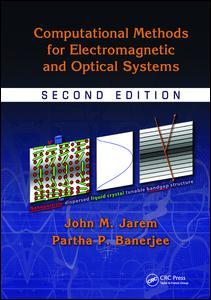Computational Methods for Electromagnetic and Optical Systems (2nd Ed.) Optical Science and Engineering Series
Auteurs : Jarem John M., Banerjee Partha P.

The current rapid and complex advancement applications of electromagnetic (EM) and optical systems calls for a much needed update on the computational methods currently in use. Completely revised and reflecting ten years of develoments, this second edition of the bestselling Computational Methods for Electromagnetic and Optical Systems provides the update so desperately needed in this field.
Offering a wealth of new material, this second edition begins with scalar wave propagation and analysis techniques, chiral and metamaterials, and photonic band gap structures. It examines Pontying vector and stored energy, as well as energy, group, and phase velocities; reviews k-space state variable formation with applications to anistropic planar systems; and presents full-field rigorous coupled wave analysis of planar diffraction gratings with applications to H-mode, E-mode, crossed gratings, single and multilayered diffraction grating analysis, and diffraction from anistropic gratings.
Later chapters highlight spectral techniques and RCWA as applied to the analysis of dynamic wave-mixing in PR materials with induced transmission and reflection gratings and demonstrate the RCWA algorithm to analyze cylindrical and spherical systems using circular, bipolar cylindrical, and spherical coordinates. The book concludes with several RCWA computational case studies involving scattering from spatially inhomogeneous eccentric circular cylinders, solved in bipolar coordinates. Many of these examples apply the complex Poynting theorem or the forwardscattering (optical) theorem to validate numerical solutions by verifying power conservation.
Using common computational tools such as Fortran, MATLAB, COMSOL, and RSOFT, the text offers numerous examples to illuminate the material, many of which employ a full-field vector approach to analyze and solve Maxwell?s equations in anisotropic media where a standard wave equation approach is intractable. Designed to introduce novel spectral computational techniques, the book demonstrates the application of these methods to analyze a variety of EM and optical systems.
Mathematical Preliminaries. Scalar EM Beam Propagation in Inhomogeneous Media. EM Wave Propagation in Linear Media. Spectral State Variable Formulation for Planar Systems. Planar Diffraction Gratings. Application of RCWA to Analysis of Induced Photorefractive Gratings. Rigorous Coupled Wave Analysis of Inhomogeneous. Rigorous Coupled Wave Analysis of Inhomogeneous Bipolar Cylindrical Systems. Bipolar Coordinate RCWA Computational Examples and Case Studies.
Date de parution : 05-2017
17.8x25.4 cm
Date de parution : 05-2011
Ouvrage de 556 p.
17.8x25.4 cm
Thèmes de Computational Methods for Electromagnetic and Optical... :
Mots-clés :
PR Material; Em Scattering; Mathematical Preliminaries; State Variable Method; EM Wave Propagation in Linear Media; Bipolar Coordinate; Planar Diffraction Gratings; Gaussian Beam; Rigorous Coupled Wave Analysis of Inhomogeneous; Bipolar Coordinate RCWA Computational Examples and Case Studies; RCWA; State Variable Analyses; Hankel Transform; State Variable Equations; Isotropic Dielectric Materials; Plane Wave Incidence; Exponential Fourier Series; SV Matrix; PR Medium; RMS Difference; PR Crystal; Wave Propagation; IEEE Microw; NLS Equation; Em Incident Wave; Plane Wave; Nim; Ip Ol Ep; Dielectric Cylinder



